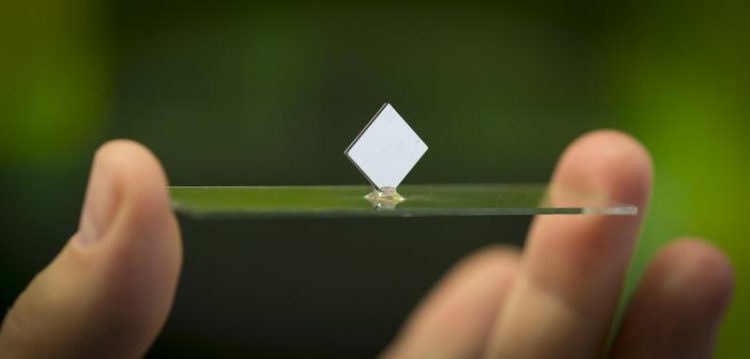Piggyback battery for microchips: TU Graz researchers develop new battery concept

The micro battery is only a few millimetres big and achieves performances which can compete with today’s best available Li-ion battery systems © Lunghammer – TU Graz
Small electrical gadgets, such as mobile phones, tablets or notebooks, are indispensable accompaniments of everyday life. Integrated circuits in the interiors of these devices monitor, control and regulate the most varied processes.
A ubiquitous trend in microelectronics is towards the smaller, more mobile and more diverse. And this shows how important the research results published in Scientific Reports by the research team led by Michael Sternad and Martin Wilkening from the Christian Doppler Laboratory for Lithium Batteries at TU Graz’s Institute for Chemistry and Technology of Materials are.
The on-board power supply of a microchip could definitely extend the range of applications of microelectronics.
Mini battery for microchips
One result of the many years of basic research at the CD Laboratory for Lithium Batteries at TU Graz shows how monocrystalline silicon, which the microchips consists of, can be used directly as a battery electrode (anode). Thus the microchip not only houses the electronics, but is at the same time an important part of a mini battery providing electrical energy, e.g. for sending and receiving information.
“Normally you cannot use single crystalline silicon as a battery component on its own because it expands considerably when implemented with lithium, starts to crack and is gradually destroyed,” explains Michael Sternad, researcher at the Christian Doppler Laboratory for Lithium Batteries at TU Graz. “We use the doped semiconductor silicon of the chip directly. However, it is first carefully microstructured using a knowledge of the crystal axes and then electrochemically specially activated,” explains Michael Sternad.
Powerful and economical
Besides the enormous storage capacity (more than 1000 mAh/g) and a high power efficiency (Coulomb efficiency >98.8 %) of the silicon electrode, what was especially surprising for the researchers was the fact that the small silicon towers of which the anode of the lithium battery consists withstand more than a 100 full charge and discharge cycles with loss of capacity of only a few per cent.
Thus the electrochemical service life of the micro battery outperforms the average period of use of a sensor or a probe. Martin Wilkening, head of the Institute for Chemistry and Technology of Materials and the CD Lab for Lithium Batteries, is very enthusiastic about this mini power station:
“The micro battery is only a few millimetres big and achieves performances which can compete with today’s best available Li-ion battery systems. Moreover, several thousand cells can be produced in parallel on a semiconductor silicon wafer, so that unit prices of only a few cents would be achievable.”
Christian Doppler Laboratory for Lithium Batteries: ageing effects, technology and new materials
The Christian Doppler Laboratory for Lithium Batteries at the Institute for Chemistry and Technology of Materials at TU Graz was established in 2012 and is committed to developing new concepts for lithium batteries. In addition to Si micro batteries, solid-state Li batteries are also being investigated. The corporate partners of the CD Laboratory are AVL List GmbH and Infineon Technologies Austria AG.
The research results were published in Scientific Reports
Contacts:
Michael STERNAD
Dipl.-Ing. Dr.techn.
TU Graz | Institute for Chemistry and Technology of Materials
CD Laboratory for Lithium Batteries
Mobile: +43 664 463 2727 | Tel.: +43 316 873 32320
michael@sternad.com
Martin WILKENING
Univ.-Prof. Dr.rer.nat.
TU Graz | Institute for Chemistry and Technology of Materials
CD Laboratory for Lithium Batteries
Mobile: +43 664 88796957 | Tel.: +43 316 873 32330
wilkening@tugraz.at
http://www.nature.com/articles/srep31712
http://www.lithium.tugraz.at/
http://bit.ly/2bxBBOC
Media Contact
All latest news from the category: Power and Electrical Engineering
This topic covers issues related to energy generation, conversion, transportation and consumption and how the industry is addressing the challenge of energy efficiency in general.
innovations-report provides in-depth and informative reports and articles on subjects ranging from wind energy, fuel cell technology, solar energy, geothermal energy, petroleum, gas, nuclear engineering, alternative energy and energy efficiency to fusion, hydrogen and superconductor technologies.
Newest articles

Security vulnerability in browser interface
… allows computer access via graphics card. Researchers at Graz University of Technology were successful with three different side-channel attacks on graphics cards via the WebGPU browser interface. The attacks…

A closer look at mechanochemistry
Ferdi Schüth and his team at the Max Planck Institut für Kohlenforschung in Mülheim/Germany have been studying the phenomena of mechanochemistry for several years. But what actually happens at the…

Severe Vulnerabilities Discovered in Software to Protect Internet Routing
A research team from the National Research Center for Applied Cybersecurity ATHENE led by Prof. Dr. Haya Schulmann has uncovered 18 vulnerabilities in crucial software components of Resource Public Key…





















